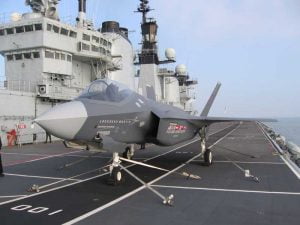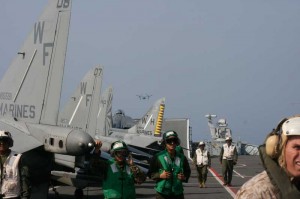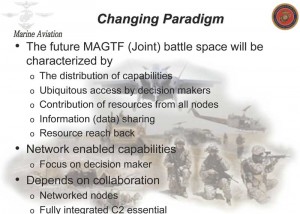
The role of the air element for the USMC is essential to the future of the USMC. One can have a police force with military uniforms or one can have a flexible military force enabled by full spectrum capability. The choice depends upon the central role provided by an integrated air element for USMC operations and options. The air element is the strategic glue, which enables diversified, decentralized and flexible USMC operations.
The aviation element within the USMC force structure plays a number of crucial functions. Because of the integrated nature of air and ground elements, it would be difficult to conceive of effective distributed operations without the air element.
First, the air component provides crucial strike components in support of the ground commander. Because the USMC lacks the organic ground firepower of US Army forces, the air component provides the ground commander with essential strike support. From this standpoint, both fixed and rotary wing air operate as flying gunships.
Second, the unmanned and manned elements of USMC aviation provide essential ISR and C2 capabilities for the ground commander. Indeed, because of USMC doctrine and training, USMC pilots think like the ground forces and consider themselves as part of any ground operation.

Third, the USMC is an expeditionary force. As such, the air components enable the strike and C4ISR capabilities to facilitate rapid advance against adversaries on the battlefield or to operate in a distributed manner to change the very character of the battlefield or of military operations. And air is an enabler for operations from the seabase, which figures prominently in USMC and USN thinking for the years ahead.
With regard to rapid advance, the USMC in the assault on Baghdad was able to use its fixed wing fighters for close air support without its ground forces waiting for the movement of artillery pieces. The KC-130s operated off of highways to support flexible ground and air operations. Bringing the tankers along with the troops is an essential element, and protection of the tankers as well as the ground forces is a crucial role for USMC tactical air.
But tac air does not simply play a close air support (CAS) role in any traditional sense. It is an enabler for distributed operations when such operations are essential to either conventional strike or counter-insurgency warfare. USMC aviation has allowed the USMC ground forces to operate with greater confidence in deploying within the civilian population in Iraq. Aviation’s roles in both non-kinetic and kinetic operations have allowed the USMC to avoid operating within “green zones” so as to facilitate greater civil-military relations. Aviation has also provided an integrated asset working with the ground forces in joint counter-IED operations.
And quite obviously, battlefields of the future will require the USMC to operate upon many axis of attack simultaneously. Such an operation is simply impossible without a USMC aviation element. For the USMC thinks ground in the air and the forces on the ground can rely 24/7 on USMC aviation forces to be with them in the ground fight.

An additional aspect of the expeditionary focus of the USMC is the central role of the seabase. In a famous moment in the initial Afghanistan operation, the USMC operated from ships to move deep inland to operate against the Taliban. Task Force 58 was in essence a seabasing operation as the USMC leadership sees it, and an example of what the USMC needs to be prepared and supported to do in the years ahead. Task Force 58’s (TF-58) combat operations in Afghanistan during Operation Enduring Freedom (OEF) in 2001 covered 450 nm to establish Camp “Rhino” and then operated over 750 nm to Kabul. Imagine even contemplating doing this with out integrated airpower!
The new air platforms fit into the overall approach taken by the USMC. The Osprey will provide unique capabilities, which will allow the “ground” forces to engage in envelopment operations that Napoleon could only have dreamed about. And in operations such as when the USMC flew their Osprey’s onto British warships demonstrating the versatility the USMC provides to maritime operations as well.
The F-35 will be a “first generation flying combat system” which will enable air-ground communication and ISR exchanges unprecedented in military history. The pilot will be a full member of the ground team; the ground commanders will have ears and eyes able to operate in a wide swath of three-dimensional space.

In many ways, the USMC is spearheading ways to re-shape the ability to connect forces. In part this is due to two core efforts central to the USMC.
In short, the new technology will fit within the operational envelope already evolved by the USMC. And this operational approach can provide an important input to evolving integration of air and ground assets for the US approach to the transformation of the overall joint force structure.
———-
Posted August 13th, 2009

